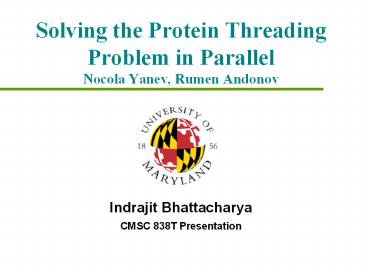Solving the Protein Threading Problem in Parallel Nocola Yanev, Rumen Andonov - PowerPoint PPT Presentation
1 / 19
Title:
Solving the Protein Threading Problem in Parallel Nocola Yanev, Rumen Andonov
Description:
Is a given target sequence likely to fold to a 3D template core? Find the alignment that minimizes some ... Objective function coefficients generated from FROST ... – PowerPoint PPT presentation
Number of Views:32
Avg rating:3.0/5.0
Title: Solving the Protein Threading Problem in Parallel Nocola Yanev, Rumen Andonov
1
Solving the Protein Threading Problem in
ParallelNocola Yanev, Rumen Andonov
- Indrajit Bhattacharya
- CMSC 838T Presentation
2
Motivation
- Problem paper is trying to solve
- 3D structure prediction using threading
- Is a given target sequence likely to fold to a 3D
template core? - Find the alignment that minimizes some score
function - NP-complete optimal solution not possible
- MAX-SNP-hard arbitrary approximation not
possible - Why do we care
- 3D structure determines biological function of
protein - Amino acid sequence (almost) uniquely determines
3D structure - Threading is usually less accurate than
comparative modeling but easier to solve
3
Talk Overview
- Overview of talk
- Motivation
- Techniques
- Evaluation
- Related work
- Observations
4
Techniques
- Approach
- Reduce the problem to some known theoretical
problem of interest - In this case, network flow
- Use existing tools for solving the theoretical
problem efficiently - CPLEX
- Explore possibilities for parallelizing the
problem - Investigate the intrinsic hardness for real
biological examples
5
Mathematical Formulation
6
Reduction to Network Flow An Example
7
Reduction to Network FlowVariables and
Constraints
- Standard Network Flow
- Variable xi,t for each segment to position
assignment - Restricted to 0, 1
- With standard flow conservation constraints
- Additional cost for non-local interactions
- Variable zi,t,i,t for each non-local
interaction - Restricted to 0, 1
- Constrained to sum to 1 for each non-local pair
(i, i) - Upper bounded by flow entering (i, t) and leaving
(i, t)
8
Drawbacks of Approach
- Integer programming is hard to solve!
- Relax to linear programming with (0, 1) variables
- Approximate to integer solution using standard
heuristics - Existing tools like CPLEX
- Huge number of variables
- For 36 segments and 81 positions, IP problem has
741264 rows, 360945 columns and 54145231 non-zero
variables! - Need to reduce number of variables and
constraints - Calls for parallelization if possible
9
Parallel Solution
- Utilize special flow constraints
- Split into sub-problems that may be solved
parallely - Split the k-th layer in the graph into r
intervals - Force path for a sub-problem to pass through a
particular interval in the layer - Pass best bound for objective function found so
far as parameter to sub-problem - Sub-task aborts when dual objective function
exceeds the current best bound
10
Improving Parallel Solution
- Drawback Hardest Sub-Problem Dominates!
- Parallel strategy was found to be slower than the
sequential! - Sub-problems can potentially become harder to
solve - Many more difficult sub-problems than easy ones
- Solution
- Break the atomicity of the tasks
- Each sub-task periodically checks the current
best bound and updates its cut-off - Extra overhead is still small compared to task
granularity - Now the easiest executing sub-task dominates!
11
Evaluation
- Experimental environment
- Real protein sequences
- ILOG CPLEX Callable Library
- SUN Ultra-Sparc II, 450 Mhz
- Objective function coefficients generated from
FROST - Maximum of 7 processors and 29 sub-problems
- Evaluation results
- Sequential version much faster than previous
branch-and-bound results for the same problem
formulation - Time taken comparable to PROSPECT
- Splitting and parallelization significantly
improve turnaround - Really tiny gap between relaxed LP and ILP
solutions - Mostly integer solutions even for relaxed LP!
12
Result Tables
Comparison with branch and bound algorithm
- Comment Self threading results in significantly
lower scores (as should be)
13
Result Tables
- Comment Tiny relaxation gap. (significance?)
14
Result Tables
Size of the LP formulation
- Comment LP problem size is still too large.
15
Result Tables
Performance with parallel sub-tasks
- Comment Longer times with more sub-problems??
16
Related Work
- Similar / previous approaches
- Lathrop and Smith, 1998
- Uses same cost function
- Branch and bound algorithm for searching the
space of threadings - Xu, Xu and Uberbacher, 1998
- Divide and conquer algorithm
- Xu, Li, Lin, Kim and Xu, 2003
- Linear programming formulation
- Solved using bb algorithm
- None of the above suggest any parallelizing scheme
17
Observations
- Points of Interest
- Mapping to a known problem of interest
- Nicely utilizes particular constraints to break
into independent subtasks - Threading of real amino acid sequences seems
possible - Raises interesting questions about real-life
protein threading being in P - Solver tailored for this particular problem may
yield better results
18
Observations
- Criticism
- Not enough experiments with large number of
subtasks and processors to show scaling - Prohibitively large number of variables and
constraints - How accurate are the objective function
coefficients? - What is the resolution of the objective function?
- Threading onto multiple sequences for prediction
still looks daunting - Not clear how to extend the idea for 3-way and
more complex interactions - Improvements
- Seems possible to break up the sub-tasks
recursively
19
Thank you!































